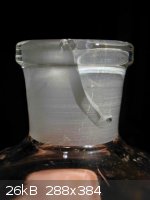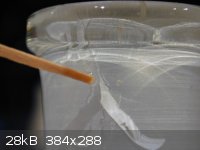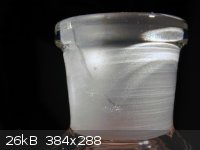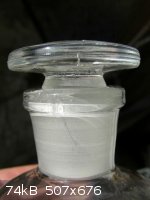lastlokean
Harmless

Posts: 10
Registered: 28-2-2013
Member Is Offline
Mood: Confused
|
|
Hairline Crack - Repair With Epoxy?
So... I got a new distillation setup after my last one became a pile of dust due to an unfortunate incident with moving.
First few distillations = No issues.
Then I decide I need to do a vacuum distillation... Mostly for fun. Sadly the vaccum take-off adapter hairline cracked instantly after vacuum was
applied. 
The crack is under an inch short, seemingly water tight. Thankfully it is not by the joint, but in the middle of the 'bend'.
My initial thought was... Throw this POS away. Last time I get glassware from China. On second thought I'm thinking of trying to seal the hairline
crack from both sides with a high quality epoxy. Obviously this is 'madness'.
Anyone have any words of advice on sealing a hairline glass fracture with epoxy? Could it ever hold up to a vacuum?
You can't spell geek without EE.
That's Right I'm an electrical engineer with a passion for chemistry...
|
|
|
DraconicAcid
International Hazard
    
Posts: 4278
Registered: 1-2-2013
Location: The tiniest college campus ever....
Member Is Offline
Mood: Semi-victorious.
|
|
Repaired or not, I would not trust it under vacuum. Rather than epoxy, I'd wrap it in duct tape. If it does break, it prevents it from shattering in
such a way that it throws shards all over the place, and makes it easier to clean up.
Please remember: "Filtrate" is not a verb.
Write up your lab reports the way your instructor wants them, not the way your ex-instructor wants them.
|
|
|
lastlokean
Harmless

Posts: 10
Registered: 28-2-2013
Member Is Offline
Mood: Confused
|
|
Thanks for the advice. I think I'm going to:
1: Epoxy it.
2: Sand it smooth.
3: Wrap it in duct tape.
4: Epoxy over duct tape.
I will order a replacement as well... From someplace other than china.
You can't spell geek without EE.
That's Right I'm an electrical engineer with a passion for chemistry...
|
|
|
bahamuth
Hazard to Others
  
Posts: 384
Registered: 3-11-2009
Location: Norway
Member Is Offline
Mood: Under stimulated
|
|
Why bother with such a cheap piece of glassware. Cracks tend to propagate in glass as it is thermally cycled, sometimes instantly without any warning.
I'd go with safety, instead of it breaking when it really shouldn't.
As a comparison, you won't screw a crack whore with a rubber that has been in you wallet for ten years now would you...
Any sufficiently advanced technology is indistinguishable from magic.
|
|
|
lastlokean
Harmless

Posts: 10
Registered: 28-2-2013
Member Is Offline
Mood: Confused
|
|
Rofl.... I suppose you have a point. Obviously I would never trust the piece of glass under any volatile or extreme situation...
Mostly because it will be a few weeks before I can order more glassware. I was mostly hoping to just get it functioning for the output of a condenser
again. As in the piece would not really be exposed to any thermal stress.
I was mostly curious to see if anyone had experience repairing glassware with epoxy. Mostly because I was under the impression that epoxy was ~ as
strong as glass...
You can't spell geek without EE.
That's Right I'm an electrical engineer with a passion for chemistry...
|
|
|
watson.fawkes
International Hazard
    
Posts: 2793
Registered: 16-8-2008
Member Is Offline
Mood: No Mood
|
|
Quote: Originally posted by lastlokean  | | As in the piece would not really be exposed to any thermal stress. [...] Mostly because I was under the impression that epoxy was ~ as strong as
glass... |
Thermal stress is only one source for mechanical stress. Pressure differentials, such as drawing
vacuum, are another. Any kind of cyclic mechanical stress will cause a crack tip in glass to propagate and thus a crack to elongate.
Epoxy is strong, but not strong enough to deal with the forces generated at the tip of a crack. That's why cracks propagate in the first place. The
only way to counteract this force to prevent the two sides of the crack from moving with respect to each other. You can do that with concrete (more or
less) but it's basically impossible with glass. You have to (1) have an adhesive of such low viscosity that it can get between the two sides of a
crack, (2) of sufficient strength once it cures, and (3) have a way of opening the crack up to all the adhesive to penetrate. Just go try getting all
three at once on glass only 1-2 mm thick. Instead, what you have to do is to eliminate the crack tip by fusing the two sides of the crack together
with heat.
|
|
|
Oscilllator
National Hazard
   
Posts: 659
Registered: 8-10-2012
Location: The aqueous layer
Member Is Offline
Mood: No Mood
|
|
I think I've posted this somewhere else before, but I once repaired a hairline crack in a test tube by heating it red hot with a propane lamp. The
hairline crack completely disappeared. Now it was probably under a fair bit of stress, but it held up well for a few months until it came to its
demise in an unrelated incident  . .
Not saying you should conduct this on that bigger and more complex piece like a take-off adapter, but it can be done.
|
|
|
Organikum
resurrected
    
Posts: 2329
Registered: 12-10-2002
Location: Europe
Member Is Offline
Mood: busy and in love
|
|
I have used, Oh! No! I actually still use from time to time glassware which is held together mostly by strong PTFE-tape.
Mostly broken grounded joints.
Never had a problem with it even vacuum was fine.
I sometimes think just find something what gives PTFE tape (thick one) structural integrity and to build everything from this, just one or two times
use and throw out.
I strongly dislike cleaning glassware.
/ORG
[Edited on 25-4-2013 by Organikum]
|
|
|
CycloKnight
Hazard to Others
  
Posts: 128
Registered: 4-8-2003
Member Is Offline
Mood: Still waiting for the emulsion to settle.
|
|
Quote: Originally posted by Oscilllator  | I think I've posted this somewhere else before, but I once repaired a hairline crack in a test tube by heating it red hot with a propane lamp. The
hairline crack completely disappeared. Now it was probably under a fair bit of stress, but it held up well for a few months until it came to its
demise in an unrelated incident  . .
Not saying you should conduct this on that bigger and more complex piece like a take-off adapter, but it can be done. |
^^This.
I have done many times, whenever I see a crack in a small item the glassware just goes under the blowlamp for a while. No sweat. The glass will anneal
thus neutralising stresses, but should be cooled slowly. I think it works okay for small items, for large items (RBF, desiccator, etc) I'd just
replace.
|
|
|
Pyro
International Hazard
    
Posts: 1305
Registered: 6-4-2012
Location: Gent, Belgium
Member Is Offline
Mood: No Mood
|
|
I thought one needed temperatures in excess of 500*C for that to happen at an appreciable rate.
all above information is intellectual property of Pyro.  |
|
|
argyrium
Hazard to Others
  
Posts: 123
Registered: 3-2-2008
Location: Pacific
Member Is Offline
Mood: No Mood
|
|
Hi,
Just a couple of thoughts on the use of epoxies for glass repairs. Over the years I have repaired literally hundreds glass and ceramic objects for
museums and private collectors. Many of these have had to confer strength sufficient that the object could be actually put back into use, and not
only cosmetically.
The epoxies I most often use are Epotek 301-2 or 301, and HXTAL NYL- 1 - depending on the refractive indices of the glass involved and the degree of
acceptable yellowing that will occur over time.
The HXTAL NYL- 1, and Epotek 301-2 are not the easiest materials to use but have remarkable properties. The cure rate of the HXTAL NYL- 1 at RT is
about a week and for the 301-2 overnight. When properly cured these materials will be stronger than the glasses they applied to, i.e. the glass will
fail before the join (at RT...).
The operational useful range of the 301-2 is - 55°C to 200°C and the HXTAL is probably less than 100° (depending or the Temperature/cure schedule)
Both have Tgs of around 80° C and water-white and low viscosities
http://www.epotek.com/sscdocs/datasheets/301-2.PDF
the information for the HXTAL is a bit more difficult to come by online but here is a site of it:
http://www.glasscolor.com/files/HXTAL-NYL.pdf
I recently had a ground-glass jointed bottle (Pyrex) that I use for solvents - which had dried up. The stopper was frozen :-( Freezing the stopper
and heating the bottle may have helped along with several applications of other polar and non polar solvents. Finally tried gently prying with a
screw driver - bad. The stopper came loose but a blind crack opened and ran down from the lip to 3/4 down.
[img][/img]
Applied Epotek 301-2 from the outside with a toothpick and it capillaried pretty well into the crack.
You can see some very small voids if you look carefully. Curing was done at ~ 50° for 5 hrs.
Excess epoxy was cut away with a scalpel after curing.
Both the Epoteks and HXTAL are quite unforgiving if improperly measured/mixed.
I would think this would be fine for use on a cracked take-off under moderate vacuum, but I would not want to try it on a star-crack on an RBF with
boiling H2SO4.




|
|
|
binaryclock
Hazard to Others
  
Posts: 121
Registered: 9-4-2013
Location: Canada
Member Is Offline
Mood: Organic
|
|
Which glassware from China? It wasn't laboy/synthware was it?
Current Project: Playing with my new Laboy advanced distillery kit!
|
|
|